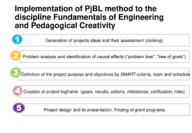 | EasyChair Smart Slide | User Guide/Log in |
| Home |

The experience of application of methods of problem-based and project-based learning was described in the training of future engineers for the light industry. Methodological issues are considered, as well as practical recommendations are formulated, for the application of these methods in teaching professionally-oriented disciplines. Examples of project design and their content are given for two specialised disciplines. They are aimed at the development of students' ability to creative thinking and problem-solving when working both independently and in a team. The method effectiveness is illustrated by the formation of students' new competencies, an increase in their motivation and experience in teamwork. The preferred styles of students' learning were studied for student groups of four different years of enrolment. The acquired learning preferences are shown to be rather stable. The correlation is studied between students' learning styles and students' success in project design activities. Moderately active learning style together with the presence of reflective thinking, as well as the preference of sensitive style, are favourable for design and implementation of class projects. The problems faced by teachers are discussed for the application of the methods mentioned above.


















